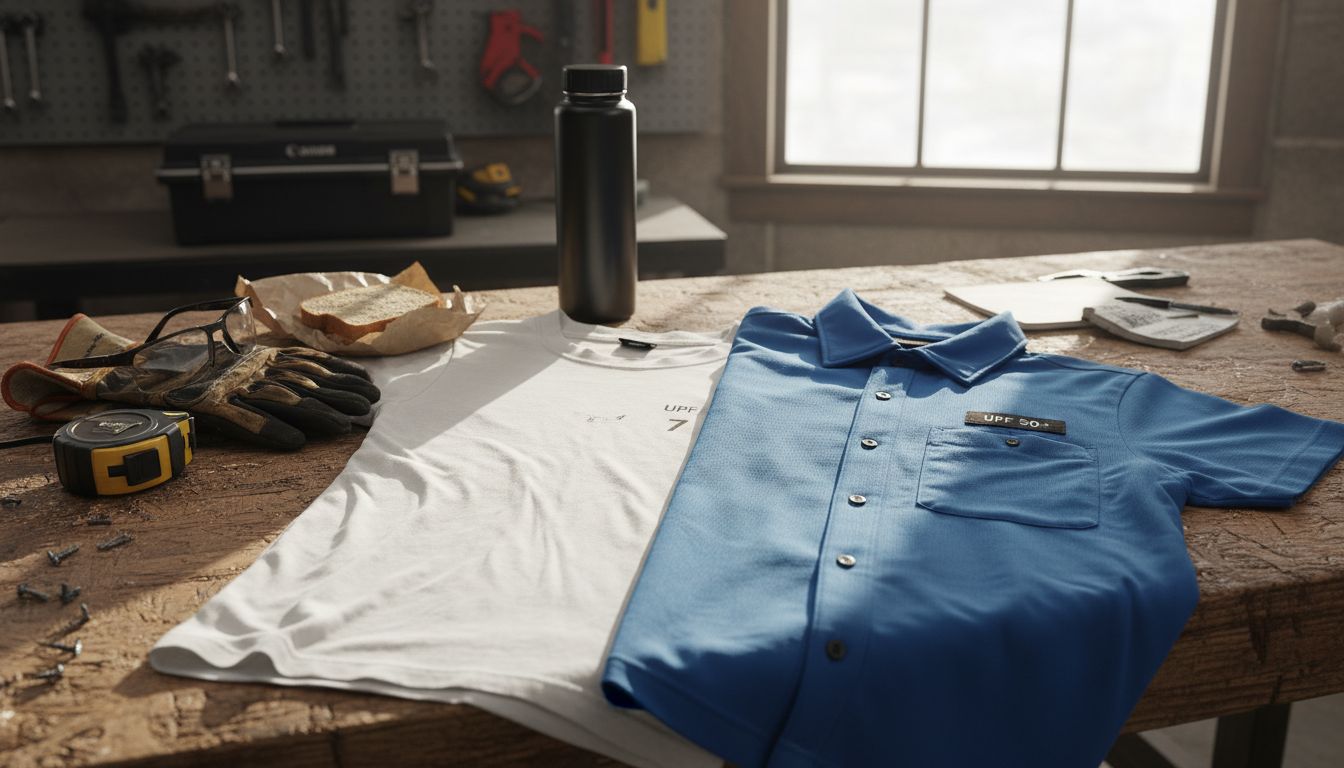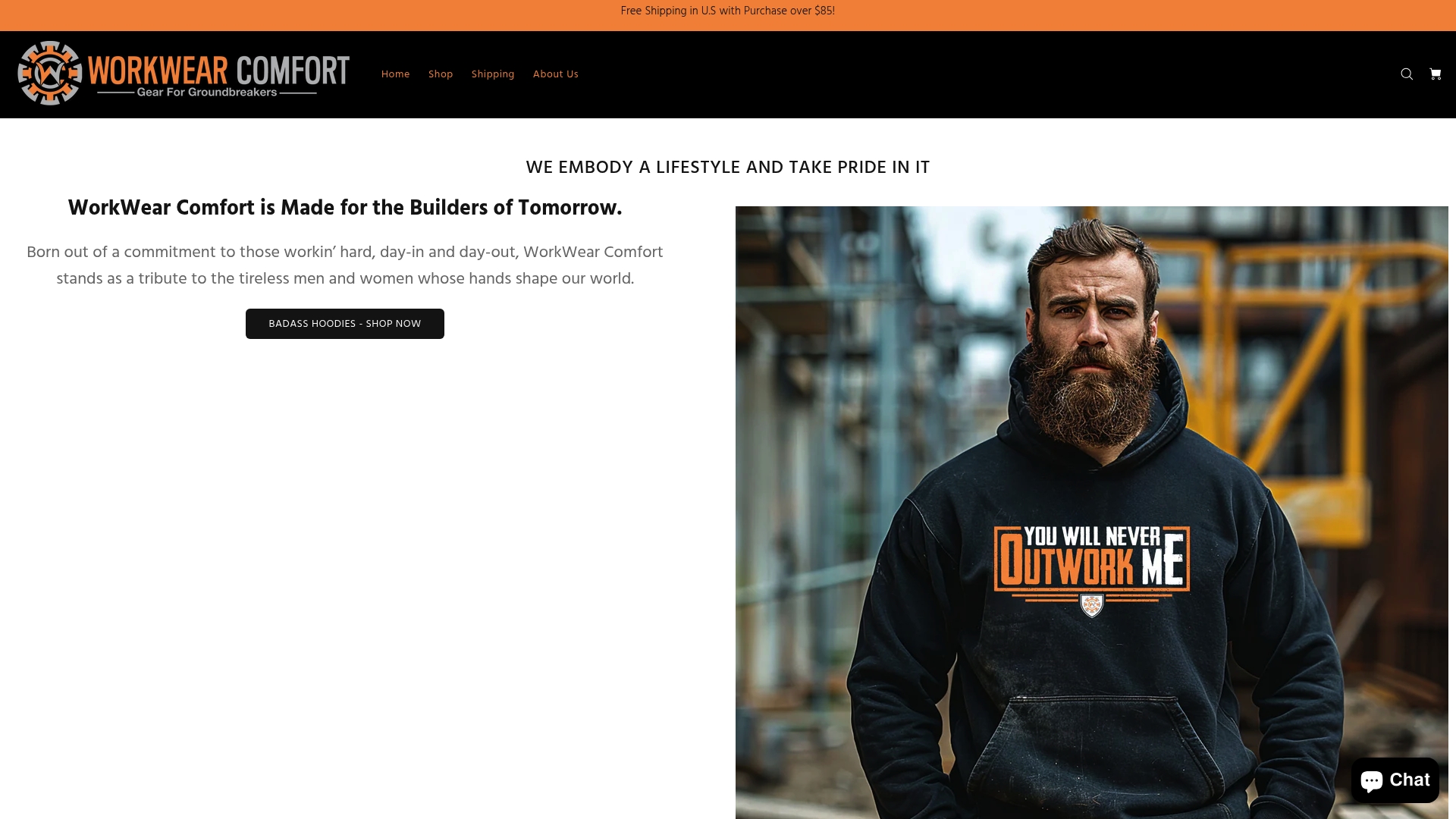Did you know that skin cancer is the most common cancer in the world, with outdoor workers facing a much higher risk due to sun exposure? Protecting yourself goes beyond sunscreen. The right workwear can act as a powerful barrier against invisible ultraviolet rays, maintaining your health while you focus on the job. This guide will help you understand how UPF-rated clothing works and how it can safeguard professionals who spend their days under the sun.
Table of Contents
- Defining UPF Protection and Core Principles
- Types of UPF-Rated Apparel for Work
- How UPF Ratings Are Measured and Labeled
- Benefits of UPF Clothing for Outdoor Workers
- Comparing UPF Protection With Other Methods
- Common Mistakes When Choosing UPF Apparel
Key Takeaways
| Point | Details |
|---|---|
| Importance of UPF Ratings | UPF ratings are essential for determining how much UV radiation clothing can block, with UPF 50+ fabrics blocking 98% of harmful rays. |
| Types of Protective Apparel | UPF-rated clothing includes a variety of garments such as long-sleeved shirts and broad-brimmed hats designed to protect outdoor workers from UV radiation. |
| Understanding Measurement | UPF ratings are scientifically categorized into levels of protection, with UPF 15–24 offering good protection and UPF 40–50+ offering excellent protection. |
| Common Mistakes | Many workers mistakenly assume all clothing provides equal UV protection; checking specific UPF ratings and selecting purposefully designed garments is crucial. |
Defining UPF Protection and Core Principles
Workwear isn’t just about durability anymore - it’s about protecting your body from invisible threats like ultraviolet (UV) radiation. Ultraviolet Protection Factor (UPF) is a critical rating system that tells you exactly how much sun protection your clothing provides, much like SPF does for sunscreen.
According to cancer prevention research, a UPF 50 fabric blocks 98% of the sun’s harmful rays, allowing only 2% to penetrate. This means workers spending hours outdoors - from construction sites to agricultural fields - can dramatically reduce their skin cancer risk by choosing the right clothing.
The core principles of UPF protection revolve around fabric technology and weave density. Factors that influence a garment’s UPF rating include:
- Fabric color (darker colors typically block more UV)
- Fabric density and thickness
- Material composition (synthetic vs. natural fibers)
- Fabric stretch and wear
As research from MD Anderson Cell Research indicates, a UPF 50+ rating means only about 1/50th of the sun’s UV rays can pass through your clothing. For hardworking professionals who spend hours under direct sunlight, this isn’t just a comfort feature - it’s a critical health protection mechanism.
Types of UPF-Rated Apparel for Work
UPF protection isn’t a one-size-fits-all solution. For hardworking professionals who spend hours under the sun, UPF-rated clothing offers comprehensive protection across multiple garment types designed to shield workers from harmful ultraviolet radiation.
According to healthcare research, UPF-rated clothing encompasses a wide range of essential workwear, including:
- Long-sleeved shirts with extended coverage
- Broad-brimmed hats for head and face protection
- Protective pants with full leg coverage
- Specialized work gloves
- Neck gaiters and face masks for additional skin shielding
Research from Harvard Health reveals an even more extensive range of sun-protective clothing options. For outdoor workers like construction crews, farmers, and landscapers, this means protection isn’t limited to just shirts and pants. Options now include specialized workwear like hoodies, dresses, skirts, shorts, leggings, and even protective swimwear.
The key is selecting garments that not only provide UPF protection but also meet the durability and functionality requirements of tough work environments. Workers should look for clothing that offers both high UV protection and the rugged performance needed to withstand demanding job sites.

How UPF Ratings Are Measured and Labeled
Understanding UPF ratings isn’t just about numbers - it’s about knowing exactly how much protection your workwear provides against harmful ultraviolet radiation. These ratings are far more than marketing hype; they’re scientifically determined measurements that can literally protect workers from skin damage.
According to UCSF Health research, UPF ratings are categorized into clear protection levels:
- UPF 15–24: Good protection
- UPF 25–39: Very good protection
- UPF 40–50+: Excellent protection
The measurement process is rigorous and standardized. As research from DermNet NZ indicates, two primary organizations in the U.S. establish the guidelines for UPF testing and labeling: the American Association of Textile Chemists and Colorists (AATCC) and the American Society for Testing and Materials (ASTM). These organizations ensure that UPF ratings provide workers with reliable, scientifically-backed information about their clothing’s sun protection capabilities.
For workers spending long hours under direct sunlight, understanding these ratings isn’t just a technical detail - it’s a critical part of personal safety equipment.
Benefits of UPF Clothing for Outdoor Workers
Ultraviolet protection isn’t just a luxury for outdoor workers - it’s a critical line of defense against serious health risks. From construction sites to agricultural fields, professionals spending hours under direct sunlight face significant exposure to harmful UV radiation that can cause long-term skin damage.
According to Skin Cancer Foundation research, UPF clothing provides a crucial physical barrier against UV radiation. This means workers can focus on their job without constantly worrying about sunburn or potential skin damage. The benefits extend far beyond immediate comfort:
- Reduced risk of sunburn
- Decreased long-term skin damage potential
- Consistent protection throughout the workday
- No need for frequent sunscreen reapplication
- Protection that doesn’t wash or sweat away
Research from the Cleveland Clinic highlights that UV protection clothing is more than just a preventative measure - it’s a proactive health strategy. By blocking harmful rays, these garments significantly lower the risk of skin cancer, which is especially critical for professionals who spend hours outdoors.
For workers in demanding environments like construction, farming, or landscaping, UPF clothing transforms sun protection from an afterthought into an integral part of personal protective equipment. It’s not just clothing - it’s a shield that works as hard as you do.
Comparing UPF Protection With Other Methods
Sun protection isn’t a one-method-fits-all solution. For outdoor workers, understanding the nuanced differences between protection methods can mean the difference between skin safety and potential long-term health risks.
According to MD Anderson Cell Research, UPF protection stands distinctly apart from traditional sun protection methods. Unlike SPF ratings that measure skin reddening time, UPF directly measures the amount of UV radiation penetrating fabric. Key differences include:
- UPF blocks both UVA and UVB rays
- SPF primarily measures UVB protection
- UPF provides consistent fabric-based protection
- SPF requires frequent reapplication
- Clothing offers physical barrier protection
Research from Brown Health highlights an important caveat: while UPF clothing offers comprehensive coverage for protected areas, it’s not a complete replacement for sunscreen. Exposed skin still requires traditional sunscreen application, making UPF clothing a complement rather than a total solution.
For workers constantly battling harsh sunlight, combining UPF clothing with strategic sunscreen use creates a multi-layered defense against UV radiation. It’s about working smarter, not just harder, when protecting your most valuable asset - your health.
Here’s how UPF protection compares to other sun protection methods:
| Feature | UPF Clothing | SPF Sunscreen |
|---|---|---|
| UV Protection Type | UVA + UVB | Mainly UVB |
| Coverage Consistency | Continuous with wear | Requires reapplication |
| Physical Barrier | Yes | No |
| Affected by Washing | No (stays protective) | Yes (washes/sweats off) |
| Protection Area | Covered skin only | All exposed skin |
| Best Use | Outdoors, physical labor | Exposed areas, touch-ups |
Common Mistakes When Choosing UPF Apparel
Sun protection clothing isn’t a simple grab-and-go purchase for outdoor workers. Many professionals make critical errors that compromise their skin’s safety without even realizing it.
According to Harvard Health research, one of the most fundamental mistakes is assuming all clothing provides equal protection. A standard white T-shirt might offer a shockingly low UPF of only 7, leaving workers dangerously exposed to harmful UV radiation. The key is intentional selection:
- Never assume regular clothing protects adequately
- Check specific UPF ratings before purchasing
- Understand that not all fabrics offer the same protection
- Look beyond color and style to actual UV blocking capabilities
- Prioritize purposefully designed sun-protective garments
Research from the University of Utah Healthcare emphasizes that fabric characteristics dramatically impact protection. Dark or bright colors, tightly woven fabrics, and loose-fitting garments provide superior UV defense. Workers should consider fabric density, weave, color, and fit - not just appearance - when selecting protective workwear.
For professionals battling long hours under intense sunlight, selecting the right UPF apparel isn’t a luxury - it’s a critical health investment. Smart choices today can prevent serious skin damage tomorrow.
Gear Up with Reliable UPF Protection You Can Trust
Spending long hours outdoors demands more than just work ethic. You need gear that fights back against harmful UV rays with proven UPF 50+ protection. The challenge is clear: finding durable apparel that offers true sun defense without sacrificing comfort or style. At WorkWearComfort.com, we understand the importance of combining rugged workwear with advanced UV protection. Our collection includes high-quality options like the UPF 50+ Sun Protection Hoodie - WorkWear Comfort that block out 98 percent of harmful rays so you can focus on your job with confidence.

Don’t leave your skin safety up to chance. Protect yourself now with gear designed for hardworking professionals just like you. Explore the full selection at WorkWearComfort.com and find the perfect sun-protective workwear built for strength and resilience. Taking this step today means investing in your health and peace of mind for every outdoor shift. Check out our UPF 50+ Sun Protection Hoodie - WorkWear Comfort collection and gear up with trusted protection that works as hard as you do.
Frequently Asked Questions
What does UPF mean in clothing?
UPF, or Ultraviolet Protection Factor, measures how much UV radiation is blocked by a fabric. A UPF rating indicates the level of protection provided, similar to the SPF rating used for sunscreen.
How are UPF ratings determined for workwear?
UPF ratings are determined through a standardized testing process that measures how much UV radiation penetrates fabric. Organizations like the American Association of Textile Chemists and Colorists (AATCC) and the American Society for Testing and Materials (ASTM) set the guidelines for this testing.
What types of clothing offer UPF protection?
UPF-rated clothing includes a variety of workwear such as long-sleeved shirts, broad-brimmed hats, protective pants, gloves, neck gaiters, and even specialized items like hoodies or swimwear, designed specifically to shield against harmful UV radiation.
Is UPF clothing sufficient on its own for sun protection?
While UPF clothing provides significant UV protection, it doesn’t replace the need for sunscreen on exposed skin. It’s recommended to combine UPF garments with sunscreen for comprehensive sun protection, especially on areas not covered by clothing.
Recommended
- What Is Workwear? A 2025 Guide for Hardworking Professionals - WorkWear Comfort
- Best Workwear for Electricians: Top Choices for 2025 - WorkWear Comfort
- Best Workwear for Hot Weather: Stay Cool & Protected in 2025 - WorkWear Comfort
- How to Prevent Sun Exposure Naturally at Work Sites – WorkWearComfort


